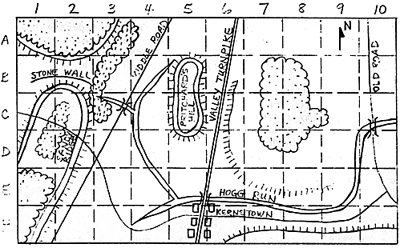The battle of Kernstown was brought about by the faulty scouting of Major Gen. T. J. "Stonewall" Jackson's cavalry commander, Col. Turner Ashby. Ashby skirmished with a small four regiment Union force on 21 March near Winchester and rushed a courier to Jackson with news of the small enemy force. Jackson, who had been eager for quite some time to pounce on a small isolated Union force, was quick to take action. He immediately sent his small army from Mount Jackson at dawn of the 22nd and marched them an incredible 36 miles during the next day and a half, arriving at Kernstown at about 2:00 P.M. on the 23rd. Jackson immediately issued attack orders to his troops, and by 3:30 they were maneuvering toward their assigned positions. Jackson's plan was to pin the Federal center and launch a vigorous attack against their right flank. The two brigades of Jackson's flanking force ran into strong opposition at the north end of Sandy Ridge. Jackson watched the battle unfold with growing concern as more and more Federal infantry appeared to thwart his clever plan. He finally realized that he must be outnumbered by at least two to one, but there was nothing he could do about it now. His flanking force fought valiantly and repulsed repeated enemy attacks, but was finally forced to withdraw, due partly to being outnumbered and partly because one of the brigades was experiencing a severe ammunition shortage. The battle ended at about 6:00. The Union force, led by Col. Nathan Kimball, a tough old veteran of the Mexican War, suffered 350 casualties to Jackson's 700. The easy victory that Jackson yearned for was not to be had today.
The scenario will begin with the 3:00 P.M. turn and end at 7:00 P.M.
Set Up
The initial dispositions, arrivals, and set up restrictions are as follows: Kimball's and Sullivan's Brigades begin the game deployed anywhere within areas D6, D7, D8, E7 and/or E6. Col. Ashby and his command begin the game deployed in areas F7, F8 and/or P9. Tyler's Brigade enters the northern map edge on the Middle Road on the 4:00 P.M. turn. The Confederate brigades of Burks, Fulkerson, and Garnett enter the southern, edge of the map on the Valley Turnpike on turn 1. The batteries of Kimball's Brigade may begin the game deployed on Pritchard's Hill. The units of Burks' Brigade may never move further north than row E of the map.
The side with the most victory points (VP) at the end of the game is the victor. Victory points are awarded according to the following schedule:
- 1 VP for every 2 enemy infantry casting casualties
3 VP for every Confed. cav, casting casualty
1 VP for every enemy gun destroyed or captured
2 VP for every enemy Brigade Leader wounded or killed
5 VP for Confed. if Col. Kimball is severely wounded or killed
20 VP for Union if Jackson is severely wounded or killed
20 VP for the side (if any) in undisputed control of Pritchard's Hill at end
10 VP for ea. Confed. unit exited off map from areas A3 or A6 during game
Confederate Order of Battle:
Col.. J. S. Burks' Brigade: 21st Va. (avg., 300 men); 42nd Va. (avg., 300 men); 48th Va. (avg., 300 men); 1st Irish Btn. (avg., 200 men); Hampden's Battery (avg., 4 Napoleons).
Col. S. V. Fulkerson's Brigade: 23rd Va. (avg., 200 men); 37th Va. (avg., 200 men); Oanville Battery (avg., 4 Napoleons).
Brig. Gen. R. S. Garnett's. Brigade: 2nd Va. (elite, 300 men); 4th Va. (elite, 300
men); 5th Va. (elite, 400 men); 27th Va. (elite, 300 men); 33rd Va.
(elite, 300 men); 1st Rockbridge Battery (avg., 7 six pd. smoothbores);
Allegheny Battery (avg., 4 Napoleons); West Augusta Battery (avg., 4
Napol eons).
Col. Turner Ashby's Cavalry: 300 elite troopers with pistols and sabers; Chew's Battery (avg., 4 rifled guns).
Union Order of Battle:
Kimball's Brigade: 8th Ohio (green, 200 men); 67th Ohio (avg., 500 men); 84th
Penn. (militia, 500 men); 14th md. (avg., 500 men); Battery H, 1st Ohio
Lt. Art. (avg., 6 Napoleons); Battery L, 1st Ohio Lt. Art. (avg., 6
Napoleons).
Col. J. C. Sullivan's Brigade: 62nd Ohio (avg., 500 men); 5th Ohio (avg.,500
men); 13th ind. (avg., 500 men); 39th Ill. (avg., 500 men); Battery E,4th
U. S. Art. (avg., 4 light rifles).
Col. E. B. Tyler's Brigade: 1st W. Va. (avg., 400 men); 29th Ohio (avg.,500
men); 110th Penn. (green, 400 men); 7th Ohio (avg., 300 men); 7th Ind..
(avg., 300 men); Battery A, 1st W. Va. Lt. Art. (avg., 4 light rifles);
Battery B, 1st 14. Va. Lt. Art. (avg., 4 light rifles).
Note: All infantry, Union and Confederate, are armed with rifled muskets.Hogg Run and the streams are fordable at any point along their course.

Back to The Zouave Vol I No. 2 Table of Contents
Back to The Zouave List of Issues
Back to Master Magazine List
© Copyright 1987 The American Civil War Society
This article appears in MagWeb (Magazine Web) on the Internet World Wide Web.
Other military history articles and gaming articles are available at http://www.magweb.com